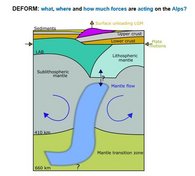DEFORM


Deformation patterns in relation to the deep configuration of the lithosphere of the Alps and their forelands – DEFORM
The objective of DEFORM project is to test the hypothesis that different processes controlling recent crustal deformation can be isolated and their relative contributions quantified if first-order characteristics of lithosphere configuration are considered in concert with physical processes. DEFORM are part of the DFG priority program 2017 4D Mountain Building (SPP MB-4D).
To test this hypothesis, we address the following scientific questions:
- Which are the main rheological characteristics of the Alps and their forelands?
- Is there a systematic and across scales relation between the distribution of observed seismicity and the rheological configuration of the lithosphere?
- How does the present-day thermomechanical configuration influence the lithosphere-scale stress field?
- How do observed motions at the surface translate through a rheologically layered lithosphere laterally and with depth, and what controls the localization of deformation?
- Which lateral (plate boundary across the lithospheric plate) and basal (mantle drag) boundary conditions are required to reproduce the deformation field observed at the surface?
- How does the rheological configuration of the lithosphere react to a glacial cycle with respect to (un)loading and cooling/heating?
- Can we predict future deformation considering the first-order variations in rheology and stress?
Approach:
In this project, we make use of the data integrated 3D crustal model of the Alps derived in the project INTEGRATE during the first phase of the 4DMB SPP. In the first phase of DEFORM project, the 3D crustal model is extended in-depth and laterally to include the mantle architecture (i.e. subducted slabs) by objectively interpreting available seismic tomography models. In order to capture the uncertainties and inherent non-uniqueness originating either from the scarce data or method, we derive end-member scenarios of the mantle architecture. We then model and compare the internal buoyancy-driven response of the end member scenarios to observed data to explain the first-order features and test their physical consistency. In addition to the uncertainties in the architecture, there also exist uncertainties in the physical properties. To quantify these uncertainties and to find the key parameters, we perform a global sensitivity analysis using the reduced basis method by an exhaustive sampling of the physical parameter space. The reduced basis model will allow us to extract the more robust mantle boundary conditions, which will be used in the second phase of the DEFORM project to understand the localization of deformation and the influence of the (un)loading of the LGM ice sheet.
Collaborators:
Dr. Denise Degen, RWTH Aachen University
Partners:
Prof. Dr. Hans-Jürgen Götze, CAU Kiel
Prof. Dr. Boris Kaus, University of Mainz
Supported by:
DFG – Deutsche Forschungsgemeinschaft
Publications:
Ajay Kumar, A. K., Cacace, M., Scheck-Wenderoth, M., Götze, H., Kaus, B. J. (2022 online): Present‐day upper‐mantle architecture of the Alps: Insights from data‐driven dynamic modelling. - Geophysical Research Letters, e2022GL099476.
https://doi.org/10.1029/2022GL099476




